Summary of Diego Rivera
Widely regarded as the most influential Mexican artist of the 20th century, Diego Rivera was truly a larger-than-life figure who spent significant periods of his career in Europe and the U.S., in addition to his native Mexico. Together with David Alfaro Siqueiros and José Clemente Orozco, Rivera was among the leading members and founders of the Mexican Muralist movement. Deploying a style informed by disparate sources such as European modern masters and Mexico's pre-Columbian heritage, and executed in the technique of Italian fresco painting, Rivera handled major themes appropriate to the scale of his chosen art form: social inequality; the relationship of nature, industry, and technology; and the history and fate of Mexico. More than half a century after his death, Rivera is still among the most revered figures in Mexico, celebrated for both his role in the country's artistic renaissance and re-invigoration of the mural genre as well as for his outsized persona.
Accomplishments
- Rivera made the painting of murals his primary method, appreciating the large scale and public accessibility—the opposite of what he regarded as the elitist character of paintings in galleries and museums. Rivera used the walls of universities and other public buildings throughout Mexico and the United States as his canvas, creating an extraordinary body of work that revived interest in the mural as an art form and helped reinvent the concept of public art in the U.S. by paving the way for the Federal Art Program of the 1930s.
- Mexican culture and history constituted the major themes and influence on Rivera's art. Rivera, who amassed an enormous collection of pre-Columbian artifacts, created panoramic portrayals of Mexican history and daily life, from its Mayan beginnings up to the Mexican Revolution and post-Revolutionary present, in a style largely indebted to pre-Columbian culture.
- A lifelong Marxist who belonged to the Mexican Communist Party and had important ties to the Soviet Union, Rivera is an exemplar of the socially committed artist. His art expressed his outspoken commitment to left-wing political causes, depicting such subjects as the Mexican peasantry, American workers, and revolutionary figures like Emiliano Zapata and Lenin. At times, his outspoken, uncompromising leftist politics collided with the wishes of wealthy patrons and aroused significant controversy that emanated inside and outside the art world.
The Life of Diego Rivera
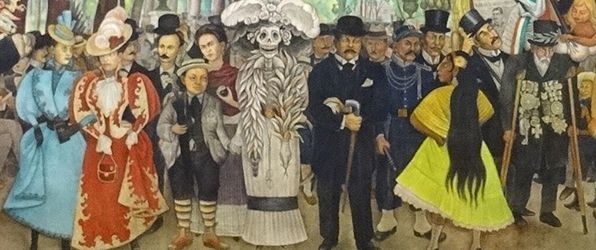
When Diego Rivera first returned home to Mexico from his artistic studies in France, he was so overcome with joy that he fainted. Later, he said, "Great art is like a tree, which grows in a particular place and has a trunk, leaves, blossoms, boughs, fruit, and roots of its own .. The secret of my best work is that it is Mexican."
Important Art by Diego Rivera
View of Toledo
A stunning tribute to two of Rivera's favorite masters—El Greco and Paul Cézanne— View of Toledo exemplifies Rivera's tendency to unite traditional and more modern approaches in his work. The landscape is a reworking of the famous 1597 landscape painting by El Greco, whose work Rivera studied during his time in Spain; Rivera's version even deploys the same viewpoint as the Spanish Old Master. At the same time, the subdued palette, flattened forms, and unconventional use of perspective suggest the artist's reverence for Cézanne, his L'Estaque landscapes. This artwork also documents the beginning of Rivera's Cubist phase.
Oil on canvas - Fundacion Amparo R. de Espinosa, Puebla
Zapatista Landscape - The Guerrilla
In this work, painted during Rivera's sojourn in Paris, the artist deployed Cubism—a style he once characterized as a "revolutionary movement"—to depict the Mexican revolutionary leader Emiliano Zapata, here seen with attributes such as a rifle, bandolier, hat, and sarape. The work's collage-like approach is suggestive of the Synthetic rather than Analytic phase of Cubism. Executed at the height of the Mexican Revolution, the painting—later described by its creator as "probably the most faithful expression of the Mexican mood that I have ever achieved"—manifests the increasing politicization of Rivera's work.
Oil on canvas - Museo Nacional de Arte, Mexico City
Motherhood - Angelina and the Child
Motherhood is a modernizing, Cubist treatment on a perennial art historical theme: the Madonna and Child. In this painting, Angelina Beloff, Rivera's common-law wife for twelve years, holds their newborn son, Diego, who died of influenza just months after his birth. The painting beautifully illustrates Rivera's unique approach to Cubism, which rejected the somber, monochromatic palette deployed by artists such as Pablo Picasso or Georges Braque in favor of vivid colors more reminiscent of those used by Italian Futurist artists like Gino Severini or Giacomo Balla.
Oil on canvas - Museo de Arte Alvar y Carmen T. de Carrillo Gil, Mexico
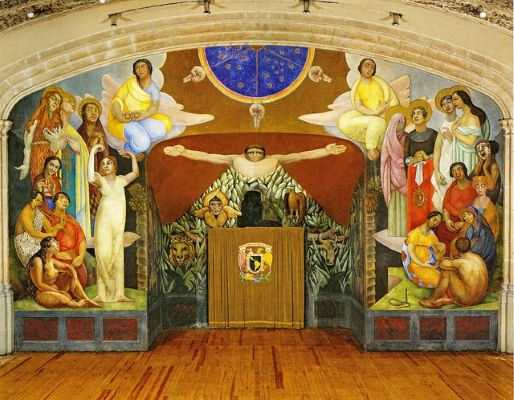
Creation
His first commission from Mexican Minister of Education Jose Vasconcelos, Creation is the first of Rivera's many murals and a touchstone for Mexican Muralism. Treating, in the artist's words, "the origins of the sciences and the arts, a kind of condensed version of human history"—the work is a complex allegorical composition, combining Mexican, Judeo-Christian, and Hellenic motifs. It depicts a number of allegorical figures—among them Faith, Hope, Charity, Education, and Science—all seemingly represented with unmistakably Mexican features. The figure of Song was modeled on Guadalupe Marin, who later became Rivera's second wife. Through such features of the work as the use of gold leaf and the monumental, elongated figures, the mural reflects the importance of Italian and Byzantine art for Rivera's development.
Fresco in encaustic with gold leaf - Museo de San Idelfonso, Mexico City
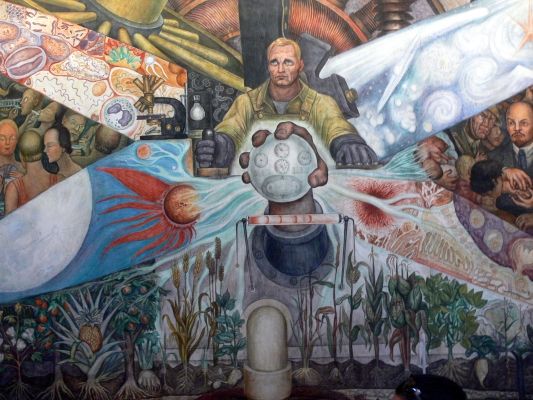
Man, Controller of the Universe (Man in the Time Machine)
As its title indicates, the painting is a powerful representation of the human race "at the crossroads" of reinforcing or competing forces and ideologies: science, industrialization, Communism, and capitalism. Revealing Rivera's dedication to Communism and other left-wing causes, the painting has at its center a heroic worker surrounded by four propeller-like blades; it contrasts a mocking portrayal of society women, seen on the left, with a sympathetic portrayal of Lenin surrounded by proletarians of different races, on the right. Commissioned by the Mexican government, this painting is a smaller but nearly identical recreation of Man at the Crossroads, the Rockefeller-commissioned mural for the soon-to-be-completed Rockefeller Center. The New York City mural was destroyed a year before this work, amid controversy over Rivera's portrait of Lenin and his subsequent refusal to remove the image.
Fresco - Palace of Fine Arts, Mexico City
Portrait of Lupe Marin
In this magnificent portrait of his second wife from whom he separated the previous decade, Rivera again reveals his profound artistic debt to the European painting tradition. Utilizing a device deployed by such artists as Velazquez, Manet, and Ingres—and which Rivera would himself use in his 1949 portrait of his daughter Ruth—he portrays his subject partially in reflection through his depiction of a mirror in the background. The painting's coloration and the subject's expressive hands call to mind another artistic hero, El Greco, while its composition and structure suggest the art of Cézanne.
Oil on canvas - Museo de Arte Moderno, Mexico City
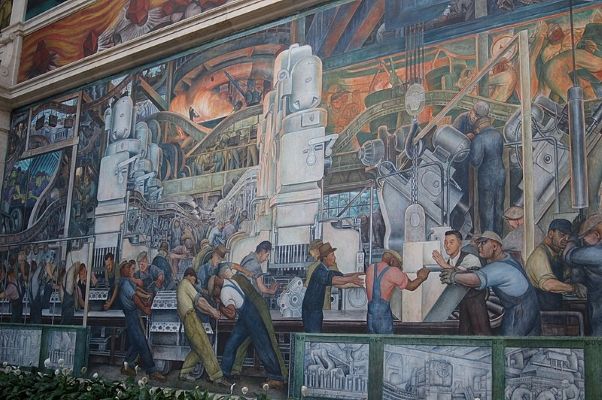
The Detroit Industry Fresco Cycle
The twenty-seven panels comprising this cycle are a tribute to Detroit's manufacturing base and workforce of the 1930s and constitute the finest example of fresco painting in the United States. Here, Rivera takes large-scale industrial production as the subject of the work, depicting machinery with exceptional attention to detail and artistry. The overall iconography of the cycle reflects the duality concept of Aztec culture via the two sides of industry: the one beneficial to society (vaccines) and the other harmful (lethal gas). Other dichotomies recur in this work, as Rivera contrasts tradition and progress, industry and nature, and North and South America. He uses multiple allegories based on the history of the continents, as well as contemporary events to build a dramatic artwork.
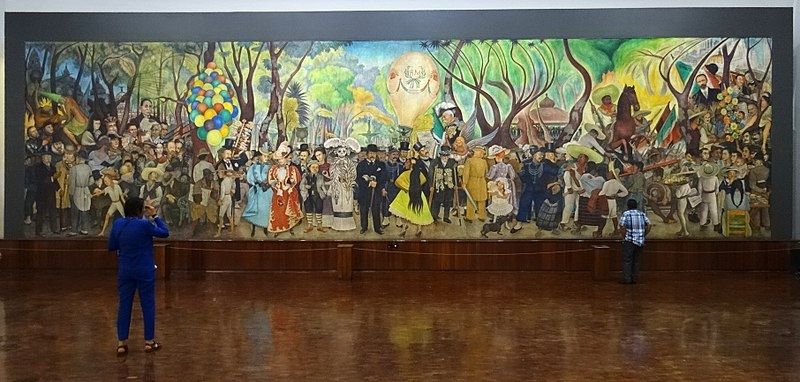
Dream of a Sunday Afternoon in Alameda Park
Rivera revisits the theme of Mexican history in this crowded, dynamic composition, replete with meaningful portraits, historical figures, and symbolic elements. Conceived as a festive pictorial autobiography, Rivera represents himself at the center as a child holding hands with the most celebrated of Guadalupe Posada's creations: the skeletal figure popularly known as "Calavera Catrina." He represents himself joining this quintessential symbol of Mexican popular culture and is shown to be protected by his wife, the painter Frida Kahlo, who holds in her hand the yin-yang symbol, the Eastern equivalent of Aztec duality.
The mural combines the artist's own childhood experiences with the historical events and sites that took place in Mexico City's Alameda Park, such as the crematorium for the victims of the Inquisition during the times of Cortes, the U.S. army's encampment in the park in 1848, and the major political demonstrations of the 19th century. As in many previous works, Rivera juxtaposes historical events and figures, deliberately rejecting the Western tradition of linear narrative.
Transportable fresco - Museo Mural Diego Rivera, Mexico City
Biography of Diego Rivera
Childhood
Diego Rivera and his fraternal twin brother (who died at the age of two) were born in 1886 in Guanajuato, Mexico. His parents were both teachers; his mother was a devoted Catholic mestiza (part European, part Indian) and his father, a liberal criollo (Mexican of European descent). Diego's exceptional artistic talent was obvious to his parents from an early age, and they set aside a room in the house for him in which he painted his first "murals" on the walls. When Diego was six, his family moved from Guanajuato to Mexico City, to avoid the tensions caused by his father's role as co-editor of the opposition newspaper El Democrata. Once in Mexico City, his mother decided to send Diego to the Carpantier Catholic College.
Early Training
By the age of ten, Rivera decided he wanted to attend art school, despite his father's desire that he pursue a military career. By the age of twelve, Rivera was enrolled full-time at the San Carlos Academy of Fine Arts, where he received training modeled on conservative European academies; one of his painting teachers had studied with Ingres, and another required Rivera to copy classical sculpture. Trained in traditional techniques in perspective, color, and the en plein air method, Rivera also received instruction from Gerardo Murillo, one of the ideological forces behind the Mexican artistic revolution and a staunch defender of indigenous crafts and Mexican culture. With Murillo's support, Rivera was awarded a travel grant to Europe in 1906.
In Spain, Rivera studied the work of El Greco, Velazquez, Goya, and the Flemish masters that he saw in the Prado Museum, and which provided him with a strong foundation for his later painting. At the studio of the Spanish realist painter Eduardo Chicharro, Rivera became acquainted with the leading figures of the Madrid avant-garde, including the Dada poet Ramon Gomez de la Serna and the writer Ramon Valle-Inclan.
In 1909 Rivera traveled to Paris and Belgium with Valle-Inclan, where he met the Russian painter Angelina Beloff who would be Rivera's partner for twelve years. Returning to Mexico City in 1910, Rivera was offered his first exhibition at the San Carlos Academy. Rivera's return coincided with the onset of the Mexican Revolution, which lasted until 1917. Despite the political upheaval, Rivera's exhibit was a great success, and the money earned from the sale of his work enabled him to return to Europe.
Back in Paris, Rivera became a fervent adherent of Cubism, which he regarded as a truly revolutionary form of painting. However, Rivera's difficult relationships with the other members of the movement came to a tumultuous end following a violent incident with the art critic Pierre Reverdy, resulting in a definitive break with the circle and the termination of his friendships with Picasso, Braque, Juan Gris, Fernand Leger, Gino Severini, and Jacques Lipchitz.
Rivera subsequently shifted his focus to the work of Cézanne and Neoclassical artists such as Ingres, as well as a rediscovery of figural painting. Receiving another grant to travel to Italy to study classical art, Rivera copied Etruscan, Byzantine, and Renaissance artworks, and developed a particular interest in the frescoes of the 14th and 15th centuries of the Italian Renaissance. In 1921, following the appointment of Jose Vasconcelos as the new Mexican Minister of Education, Rivera returned to his home country, leaving behind his partner, Angelina Beloff, as well as Marevna Stebelska, another Russian artist, with whom Rivera had a daughter, Marika, in 1919.
Mature Period
Rivera returned to Mexico with a reawakened artistic perspective, deeply influenced by his study of Classical and ancient art. There, he was afforded the opportunity to visit and study many pre-Columbian archaeological sites under the auspices of the Ministry of Education's art program. Yet his first mural painting, produced for the National Preparatory School and entitled Creation(1922), shows a strong influence of Western art. Rivera soon became involved with local politics through his membership in the Revolutionary Union of Technical Workers and his entry into the Mexican Communist Party in 1922. At this time, he painted frescoes in the Ministry of Education in Mexico City and the National School of Agriculture in Chapingo. During the latter project, he became involved with the Italian photographer Tina Modotti, who had modeled for his murals; the affair prompted him to separate from his wife at the time, Lupe Marin.
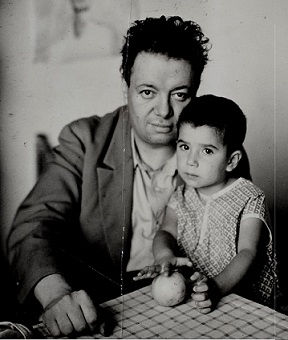
In 1927, Rivera visited the Soviet Union to attend the celebrations of the tenth anniversary of the October Revolution, an experience he found extremely inspiring. He spent nine months in Moscow, teaching monumental painting at the School of Fine Arts. Upon his return to Mexico, he married the painter Frida Kahlo, who was twenty-one years his junior, and became the director of the Academy of San Carlos. His radical ideas about education earned him enemies among the conservative faculty and student body; at the same time, he was expelled from the Communist Party for his cooperation with the government. Politically cornered, Rivera found support in the American ambassador to Mexico, Dwight W. Morrow, who commissioned him to paint a mural in the Cortes Palace in Cuernavaca depicting the history of that city. A great admirer of Rivera's work, Morrow offered the artist the opportunity to travel to the United States, all expenses paid. Rivera remained in the U.S. for four years. There, the always-prolific artist worked around the clock, painting murals in San Francisco, New York, and Detroit, celebrating the powerful forces of unions, education, industry, and art. In New York, he met with enormous popularity (his one-man show at The Museum of Modern Art had fifty-seven thousand visitors) as well as controversy (some of his murals were threatened with physical harm). Rivera's American adventure ended in 1933, when John D. Rockefeller, Jr., ordered the destruction of the mural he had commissioned for the lobby of Rockefeller Center, Man at the Crossroads, because of both Rivera's unwillingness to eliminate the portrait of Lenin and for what the Rockefeller family regarded as an offensive portrait of David Rockefeller.
Later Years and Death
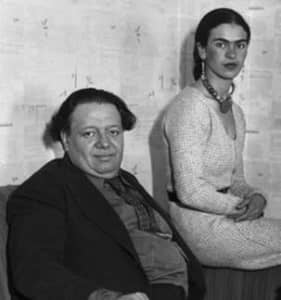
After Rivera returned to Mexico, he and Kahlo shared a house-studio in a beautiful Bauhaus-style building in Mexico City that can still be visited today. From 1929 until 1945, Rivera worked on and off in the National Palace, creating some of his most famous murals there. In 1937, he and Kahlo helped Leon Trotsky - a major Russian Communist leader - and his wife obtain political exile; the Trotskys lived with Rivera and Kahlo for two years in the "Blue House" in the suburb of Coyoacan. Two years later, Rivera and Kahlo divorced, although they remarried a year later in San Francisco, while Rivera was working for the Golden Gate International Exposition. The two had a tremendously passionate, and an extremely tumultous relationship - one that can easily extrapolated by viewing her very personal artworks. The couple would ultimately remain together until Kahlo's death in 1954.
During his last years, Diego continued to paint murals, sometimes working on portable panels. He also produced a large number of oil portraits, usually of the Mexican bourgeoisie, children, or American tourists. These works are not always remarkable, and they are often infused with a kitschy aesthetic reminiscent of Pop art. However, they were very successful during his lifetime, and provided a way for the artist to acquire more pre-Columbian objects for his spectacular collection. Today, his collection is housed in the Anahuacalli Museum, a building inspired by the Great Temple of Tenochtitlan and designed by Rivera himself.
Widowed and already sick with cancer, Rivera married for the third time in 1955 to Emma Hurtado, his art dealer and rights holder since 1946. Following a trip to the Soviet Union made in the hope of curing his cancer, Rivera died in Mexico in 1957 at age seventy. His wish to have his ashes mingled with those of Kahlo was not honored, and he was buried in the Rotunda of Famous Men of Mexico.
The Legacy of Diego Rivera
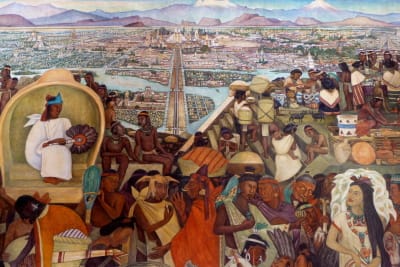
Rivera saw the artist as a craftsman at the service of the community, who, as such, needed to deploy an easily accessible visual language. This concept greatly influenced American public art, helping give rise to governmental initiatives such as Franklin Roosevelt's Federal Art Project of the Works Progress Administration, whose artists depicted scenes from American life on public buildings. With his socially and politically expansive artistic vision, narrative focus, and use of symbolic imagery, Rivera inspired such diverse artists as Ben Shahn, Thomas Hart Benton, and Jackson Pollock.
Influences and Connections

-
![Guillaume Apollinaire]() Guillaume Apollinaire
Guillaume Apollinaire -
![Frida Kahlo]() Frida Kahlo
Frida Kahlo ![Gerardo Murillo]() Gerardo Murillo
Gerardo Murillo![Leon Trotsky]() Leon Trotsky
Leon Trotsky
-
![Tina Modotti]() Tina Modotti
Tina Modotti -
![David Alfaro Siqueiros]() David Alfaro Siqueiros
David Alfaro Siqueiros -
![André Breton]() André Breton
André Breton -
![Frida Kahlo]() Frida Kahlo
Frida Kahlo ![Bertram Wolfe]() Bertram Wolfe
Bertram Wolfe
Useful Resources on Diego Rivera
- Diego Rivera, 1886-1957: A Revolutionary Spirit in Modern Art (Taschen Basic Art)Our PickBy Andrea Kettenmann
- Dreaming with His Eyes Open: A Life of Diego Rivera (Discovery Series)By Patrick Marnham
- Diego RiveraBy Pete Hamill
- Diego Rivera, The Complete MuralsOur PickBy Luis Martin Lozano, Juan Coronel Rivera
- Diego Rivera: The Detroit Industry MuralsBy Linda Bank Downs
- Mexican Muralists: Orozco, Rivera, SiqueirosOur PickBy Desmond Rochfort
 Ask The Art Story AI
Ask The Art Story AI































